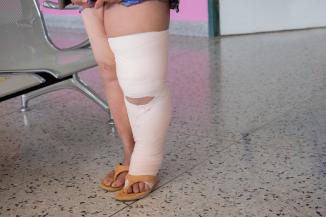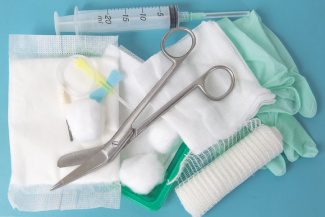The Wild Card: How Quality of Care Reduces Pressure Ulcer Incidence
February 25, 2016
Stepping forward into a model of care that is quantitative and objective is essential and most definitely the way we are headed in wound care and beyond. Using the word "care" in the same sentence with "quantitative" and "objective" may sound like an oxymoron, but care does not have to be fluffy and old-fashioned. What it must be is kind, gentle and authentic. My question is: how can the care we provide be kind, gentle, and authentic when the emphasis is so obviously on cold, hard measures and stark black and white comparisons with little value placed on the people who are the care providers?
What Goes Into Reducing the Rate of Pressure Ulcers?
If we are to improve outcomes such as reducing falls and facility-acquired pressure ulcers, then assessing patient's risk, providing workable systems to observe and monitor patients, and using complex software to collate and churn out fancy graphics is all well and good. However, this alone doesn't actually impact the incidence of falls or pressure ulcers. Measuring outcomes of care may allow risks to be managed, but real quality improvement requires a fundamental change to occur at the patient's bedside in order to positively impact outcomes in the long term. When incidence rates of pressure ulcers are well monitored and are still clearly high, what changes can be made to reduce the rate?
Initially, the course of action is simple: ensure there is a policy in place that clearly uses a validated pressure ulcer risk assessment from the point of patient admission. Health care staff must know the shortcomings of the assessment tool especially for the patient group served.
Next, the action required for differing pressure ulcer risk categories needs to be clear. Algorithms can be of use here to ensure processes and systems function within the parameters of the policy.
Maintaining and encouraging the use of equipment required to address specific issues relating to pressure ulcer development is fundamental, as otherwise policies and fancy flow sheets all become a paper exercise.
Lastly, health care staff need to have an understanding of the policy, systems and equipment to be able to optimize patient care. Staff education and training is imperative, and simply having an educator and mandatory computer-generated learning modules is not sufficient. Staff need to be given time to undergo training and they need to see examples of excellent care at the bedside.
High Quality Care, and What It Means to Deliver It
The wild card has to be thrown in here and that is the notion that care – authentic high quality care – can make a difference in reducing pressure ulcers. The ability of a bedside care provider to provide good, quality care is a persistent variable to reducing the incidence of falls and pressure ulcers, and starts and finishes with each individual staff member and their manager. Maybe it is the missing link within pressure ulcer prevention programs. It is not necessary to have a master's degree in nursing to care. Being top of the class doesn't matter, but that doesn't mean that those within this care role should not be trained well and respected for what they do.
If society valued care, it would be rewarded in some way. There would be some measure within society that clearly shows being a nurse's assistant, a nurse, or a social worker is worthwhile and of importance. High quality, authentic, care, unlike an authentic work of art, doesn't come with a certificate of authenticity, and all the customer service training in the world will not raise the consciousness of a non-caring person. The value put on caring needs to transform in a way that impacts the type of people that come to our facilities as nurses and nursing assistants.
There is a movement toward this simple goal, attracting school leavers into "Daring to Care" programs may be a start, but school leavers are very young and inexperienced in the way of delivering bedside care to an at risk patient. The concept that all people going into bedside clinical careers should start at the bedside in a basic caring role absolutely would ensure that there are more health care providers at the bedside, and give an opportunity for better bedside education. Merely increasing numbers is not the issue though. What is needed is caring people and with it a structure that provides support, observation, training and the opportunity for personal development and growth.
Developing a system of bedside care that is fashioned by nursing and taught by example to reduce falls and pressure ulcers needs to be started. The notion that just anybody can wash and dress a patient has to go. Some measure of supervision needs to be introduced into health care settings that prevents nursing assistants doing what they like, when they like and how they like. Based on my observations, nurses currently say very little about what nursing assistants do or how they go about doing it, and this really does have to change.
Care providers who care authentically check that patients are comfortable, make sure that they have had the opportunity to pee and have had help with any personal hygiene needed. They will straighten a sheet, move a pulse oximeter from a sweaty finger, and make sure the blanket is not pressed down on the toes. They will not check their cellphone while kicking their heels in a favorite hiding spot as call lights go on, waiting for a busy, caring colleague to zoom in smiling cheerily to pick up the slack.
The lack of value given to the bedside care role can attract the wrong people. If this sounds shocking, it is because it is indeed shocking. Daring to care is trying to change this notion by making it clear that caring is risky and requires commitment and, dare I say it, a lot of soul (I am not at all religious).
Why is it that it's the Red Cross that tests and certifies nursing assistants? Why don't hospitals and facilities train assistants and exact higher standards that can then attract good caring health care professionals who will in turn deserve respect and a decent wage? It is exceptionally hard for me to understand that a corporate person sitting on a board of directors can know the value of quality care but pay a wage that devalues the position to such an extent that such quality can't possibly manifest.
Bedside Care: A System of Support for Prevention Programs
Here is a quality improvement project for a large facility to try. Take $7.00-$15.00 an hour off the salary of everybody who earns more than seven times the minimum wage in your organization. Start a recruitment campaign that makes it clear you want caring people willing to be trained as bedside nurses. Offer scholarships into colleges of nursing from the groups of bedside nurses you have developed. Take your most competent LPNs and help them learn the people skills necessary to develop willing caring people at the bedside. Make it 95% on the job bedside training with LPN oversight on every shift. Pay all those entering the project $10 more an hour and increase the numbers of nursing assistants on each shift by one (the new LPN role). Sit back and watch the falls and pressure ulcers go down and the satisfaction of patients go up.
Don't tell me this is simplistic, I know. It is possible, though and somebody has to say it, somebody has to start the ball rolling, SOMBODY HAS TO DARE, OUT THERE, somebody has to care!
About The Author
Margaret Heale has a clinical consulting service, Heale Wound Care in Southeastern Vermont and draws on her extensive experience as a wound, ostomy and continence nurse in acute and long-term care settings to provide education and holistic care in her practice.
The views and opinions expressed in this content are solely those of the contributor, and do not represent the views of WoundSource, HMP Global, its affiliates, or subsidiary companies.










